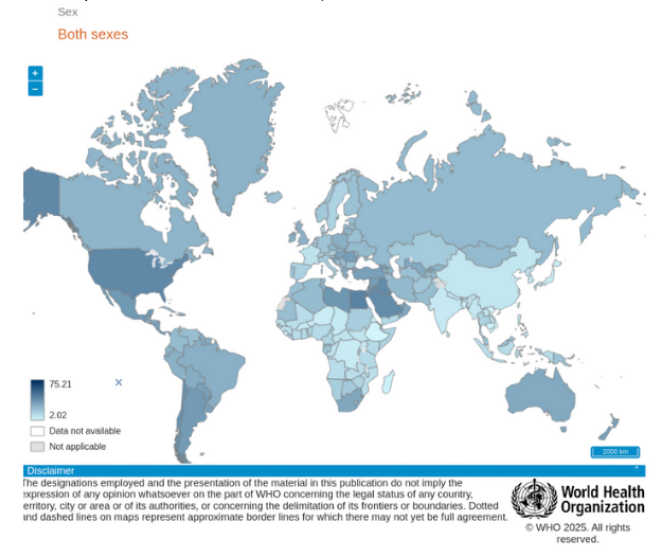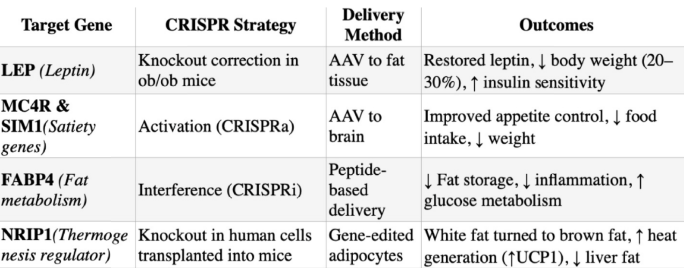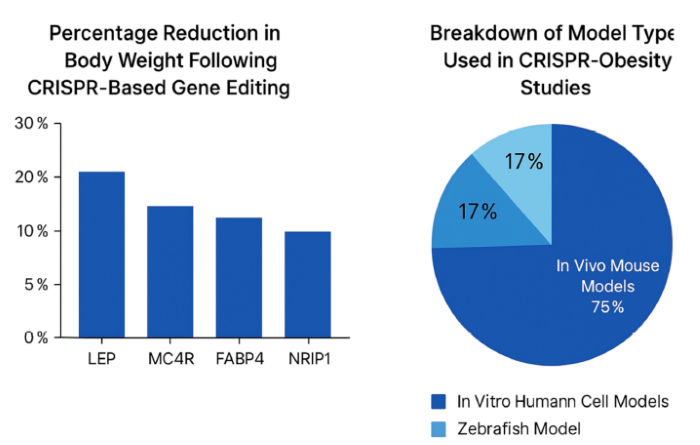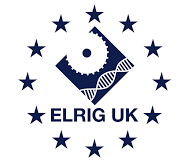This article and associated images are based on a poster originally authored by Dhruv Sunil Choudhary and presented at ELRIG Drug Discovery 2025 in affiliation with the University of Westminster.
This poster is being hosted on this website in its raw form, without modifications. It has not undergone peer review but has been reviewed to meet AZoNetwork's editorial quality standards. The information contained is for informational purposes only and should not be considered validated by independent peer assessment.

Introduction
- Obesity is a multifactorial metabolic disease and a major global public health challenge currently affecting over one billion people worldwide. Its prevalence varies by region, as shown in the WHO map below (2022 data).

Image Credit: Image courtesy of Dhruv Sunil Choudhary, in partnership with ELRIG (UK) Ltd.
- It is strongly associated with severe comorbidities, including:
- Type 2 diabetes
- Cardiovascular disease
- Non-alcoholic fatty liver disease
- Several types of cancer
- Conventional treatments (e.g., lifestyle changes, medications, bariatric surgery) often show limited efficacy or long-term sustainability.
- Genetic factors play a critical role in obesity, involving both:
- Monogenic mutations (e.g., LEP, MC4R)
- Polygenic risk variants (e.g., FTO, FABP4)
- Advances in genomics have paved the way for precision medicine, offering the potential to target an individual's unique genetic profile.
- CRISPR-Cas9, a genome-editing tool derived from bacterial immune systems, allows for precise and programmable DNA modifications.
- This technology holds promise as a transformative therapy for obesity by targeting genes involved in:
- Appetite regulation
- Lipid metabolism
- Thermogenesis
- CRISPR-based therapies may provide durable, specific, and long-term interventions for obesity.
Methodology
- Systematic review (2018-2025) of PubMed, Scopus, Web of Science
- Keywords: "CRISPR," "FTO," "MC4R," and obesity-linked genes
- Included animal and human cell models
- Extracted: Gene targets, editing methods (CRISPR, CRISPRa/i), delivery, outcomes
- Qualitative synthesis due to heterogeneity
- Risk of bias assessed via SYRCLE tool
Results
Preclinical models overview (2018-2025)
A total of 12 preclinical studies investigated the effects of CRISPR-based gene editing in obesity:
- Mouse Models (nine studies):
- Diet-Induced Obesity (DIO) mice were fed high-fat diets to simulate human obesity.
- ob/ob mice have a genetic mutation causing leptin deficiency, leading to extreme overeating.
- Human Cell Models (two studies):
- Cultured human adipocyte (fat) precursor cells were edited to assess direct effects on fat storage and metabolism.
- Zebrafish (one study):
- Used for fast gene screening to identify obesity-related targets
Gene editing strategies
- CRISPR-Cas9 (Knockout)
- Used to disrupt genes that promote fat accumulation and inflammation
- CRISPRa (Activation)
- Used modified Cas9 to turn on genes that regulate appetite and boost metabolism.
- CRISPRI (Interference)
Silenced gene activity without cutting DNA, offering a reversible approach.
Key interventions and results
Source: ELRIG (UK) Ltd.

Gene delivery methods: Strengths & limitations
- Adeno-associated Virus (AAV) vectors
- High tissue targeting and stable gene expression
- Possible immune response and genomic integration risks
- Peptide-based delivery
- Tissue-specific with low off-target activity
- Requires further optimization for in vivo efficiency
- RNPs/ dCas9 (Ribonucleoproteins/ dead Cas9) complexes
- Transient, low-risk expression with minimal off-target effects
- Less stable; may require repeated dosing
Analysis

Image Credit: Image courtesy of Dhruv Sunil Choudhary, in partnership with ELRIG (UK) Ltd.
The bar graph indicates that gene edits for LEP, MC4R, and FABP4 produced the most effective weight reduction, highlighting hormonal and metabolic targets as promising avenues. The pie chart reveals an over-reliance on rodent models (75%), which limits translational confidence.
Key limitations:
- Off-target effects were reported in <5 % of cases, but immune risks remain.
- Short follow-up periods prevent understanding of long-term efficacy.
- Small sample sizes reduce generalizability.
Future recommendations:
- Use larger, human-relevant models
- Extend study duration
- Optimize safe and scalable delivery systems
- Address ethical and regulatory concerns
Conclusion
- CRISPR-Cas9 is a promising approach for obesity therapy, targeting key genes involved in appetite regulation, metabolism, and fat storage.
- Preclinical studies showed strong metabolic benefits, particularly from editing LEP, MC4R, and FABP4.
- Translational challenges persist, including reliance on rodent models, short-term data, and limited delivery scalability.
- Future success will depend on long-term safety validation, human-relevant models, and ethical readiness.
- A multidisciplinary approach is essential - combining gene therapy, bioengineering, clinical science, and policy.
Acknowledgments
- With thanks to the staff at the University of Westminster for mentorship and guidance.
- I also acknowledge the inspiration provided by my independent venture, SANGRUV BIOSCIENCE PVT LTD.
References
- Eghbali, M., et al. (2024). Genetic Variants in the Fat Mass and Obesity‐Associated Gene and Risk of Obesity/Overweight in Children and Adolescents: A Systematic Review and Meta‐Analysis. Endocrinology Diabetes & Metabolism, 7(4). https://doi.org/10.1002/edm2.510.
- King, A., et al. (2024). A randomised controlled trial to determine the effect of genotype‐based personalised diet and physical activity advice for FTO genotype (rs9939609) delivered via email on healthy eating motivation in young adults. Nutrition Bulletin, 49(4), pp.526–537. https://doi.org/10.1111/nbu.12710.
- Lotte Kleinendorst, Abawi, O., et al. (2024). GNB1 and obesity: Evidence for a correlation between haploinsufficiency and syndromic obesity. Clinical Obesity, 14(4). https://doi.org/10.1111/cob.12661.
- Zhu, L., et al. (2021). Leptin gene-targeted editing in ob/ob mouse adipose tissue based on the CRISPR/Cas9 system. Journal of Genetics and Genomics, (online) 48(2), pp.134–146. https://doi.org/10.1016/j.jgg.2021.01.008.
About the University of Westminster
The University of Westminster is a London-based public university with a rich heritage dating back to 1838, when it was established as the Royal Polytechnic Institution, the first of its kind in London. It gained full university status in 1992 and today welcomes over 21,000 students from across the world. Known for its strong international outlook, Westminster combines academic excellence with practical, career-focused learning. Its four campuses, three in central London and one in Harrow, place students at the heart of one of the world’s most dynamic cities, offering direct access to industry, culture, and innovation.
About ELRIG (UK) Ltd.
The European Laboratory Research & Innovation Group (ELRIG) is a leading European not-for-profit organization that exists to provide outstanding scientific content to the life science community. The foundation of the organization is based on the use and application of automation, robotics and instrumentation in life science laboratories, but over time, we have evolved to respond to the needs of biopharma by developing scientific programmes that focus on cutting-edge research areas that have the potential to revolutionize drug discovery.
Comprised of a global community of over 12,000 life science professionals, participating in our events, whether it be at one of our scientific conferences or one of our networking meetings, will enable any of our community to exchange information, within disciplines and across academic and biopharmaceutical organizations, on an open access basis, as all our events are free-of-charge to attend!
Our values
Our values are to always ensure the highest quality of content and that content will be made readily accessible to all, and that we will always be an inclusive organization, serving a diverse scientific network. In addition, ELRIG will always be a volunteer led organization, run by and for the life sciences community, on a not-for-profit basis.
Our purpose
ELRIG is a company whose purpose is to bring the life science and drug discovery communities together to learn, share, connect, innovate and collaborate, on an open access basis. We achieve this through the provision of world class conferences, networking events, webinars and digital content.
Sponsored Content Policy: News-Medical.net publishes articles and related content that may be derived from sources where we have existing commercial relationships, provided such content adds value to the core editorial ethos of News-Medical.Net which is to educate and inform site visitors interested in medical research, science, medical devices and treatments.
Last Updated: Nov 10, 2025